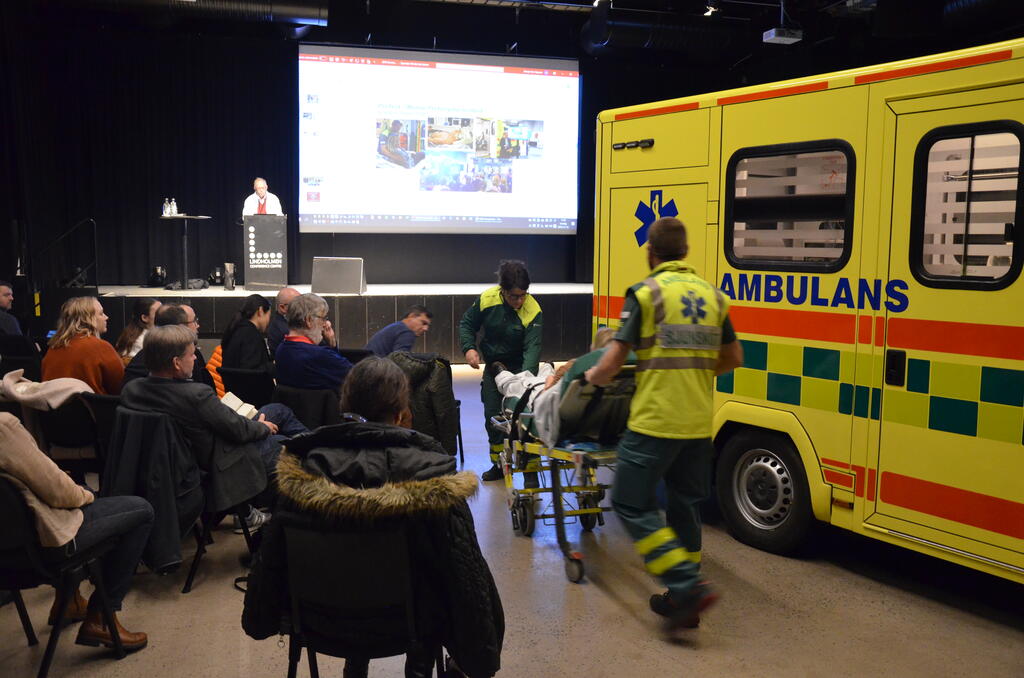A rolling research lab for mobile health care
An ambulance with full IT equipment serves as a rolling test bed, where ambulance care, research and industry meet to develop and jointly try out technology and simulate work processes. Tools such as video conferencing and digital decision support enable mobile and efficient emergency care.

Health care of today is approaching a thorough and necessary digitalisation process. As part of the transition, an ambulance from Sahlgrenska University Hospital has been been commissioned as a full-scale test ambulance and is being equipped with various IT solutions. The aim is to develop digital support for mobile medical services. The ambulance is used as a test environment for several research projects in prehospital care, with participating researchers from Chalmers University of Technology, University of Borås, Sahlgrenska Hospital and Sahlgrenska Academy.
Emergencies require quick decisions and the right actions
-I am very pleased with having such close collaboration with the researchers to develop technologies and methods that work together, says Elisabet Hammar, Head of Operations of Emergency Medical Services at Sahlgrenska University Hospital. It is all about giving the paramedical personnel the right support to assess the patient’s needs at an early stage, take the right actions and decide if and where the patient should be taken for further medical care.
An ambulance is more than just a vehicle for transporting patients. If the right treatment is initiated already on the way to the hospital, this may be crucial for the patient and have effect on the entire subsequent care chain. Significantly more than half of the most serious medical conditions, such as acute myocardial infarction, stroke, trauma and sepsis, are first treated by paramedical personnel. These groups comprise over 100,000 patients per year in Sweden with a mortality rate of over 20%.
The first rolling research lab for mobile emergency care
-The test ambulance is a unique concept, says Bengt Arne Sjöqvist, Associate Professor at the Department of Electrical Engineering at Chalmers, as well as initiator and program manager of Prehospital ICT Arena, PICTA, at Lindholmen Science Park. Creating a mobile test bed for prehospital care makes way for new possibilities. Here, we can conduct research, perform tests and develop new products and work processes. Stakeholders from healthcare, academia and industry participate in the project. Since the ambulance is mobile, we can easily meet our collaboration partners on site.
The ambulance is an extra vehicle in Sahlgrenska University Hospital’s regular ambulance fleet and is specially equipped with IT solutions and camera technology. Soon, it will be connected to the IT environment of Region Västra Götaland, making it possible, for example, to live stream video directly from the ambulance to a hospital. Specialists can then support the paramedical personnel with remote counselling, while patient data and other relevant information can be transmitted and shared.
Realistic full-scale simulations
-We will be able to perform full-scale, realistic simulations from the alarm to the delivery, using digital communication to hospital experts and systems, says Bengt Arne Sjöqvist. In addition, the researchers have a parallel IT environment of their own when necessary for development and testing. During the simulations, fictitious patient records can be used, but in case of an actual emergency the personnel will have access to the patient’s medical records directly in the ambulance.
Designing solutions based on mobile communication poses certain challenges. If the technology or the connection for some reason does not work, which occasionally will happen, a backup plan should always be prepared.
-Then, an alternative might be to return to previous routines. The safety and care of the patients are always top priority, says Bengt Arne Sjöqvist.
In order to analyse how the technology and the work processes function together, additional cameras will be installed in the test ambulance. Unlike the other camera technology, these cameras do not have the task of documenting the patient’s condition but instead record how the ambulance team use the digital decision support and other technical aids.
Involvement that inspires innovation
It is very valuable for us to be involved in the solutions that are being developed, says Elisabet Hammar. Instead of being served a ready-made solution, we can contribute and influence from a user perspective. Because the technology is tested in the real environment, in a regular but specially equipped ambulance, it takes place under very realistic forms for the paramedical personnel. This generates good ideas and an innovative mindset for us as well. In addition, even before an introduction, we are able to see how our work will be affected and how to prepare for it.
We have probably only seen the beginning of the opportunities that digitalisation offers healthcare, continues Elisabet Hammar. Healthcare is becoming more and more specialised, while at the same time needing to get closer to the patient and the user. Digital technology can help us work in a smarter way to meet the challenges facing public healthcare.
-It is clear to me that the technology that we are currently testing in the test ambulance can be useful for many more stakeholders in mobile healthcare, both for emergency conditions and for care at home, says Bengt Arne Sjöqvist. In the end, the heart of the matter is making optimal use of the limited resources of healthcare, to ensure that patients receive the right care at the right time.
